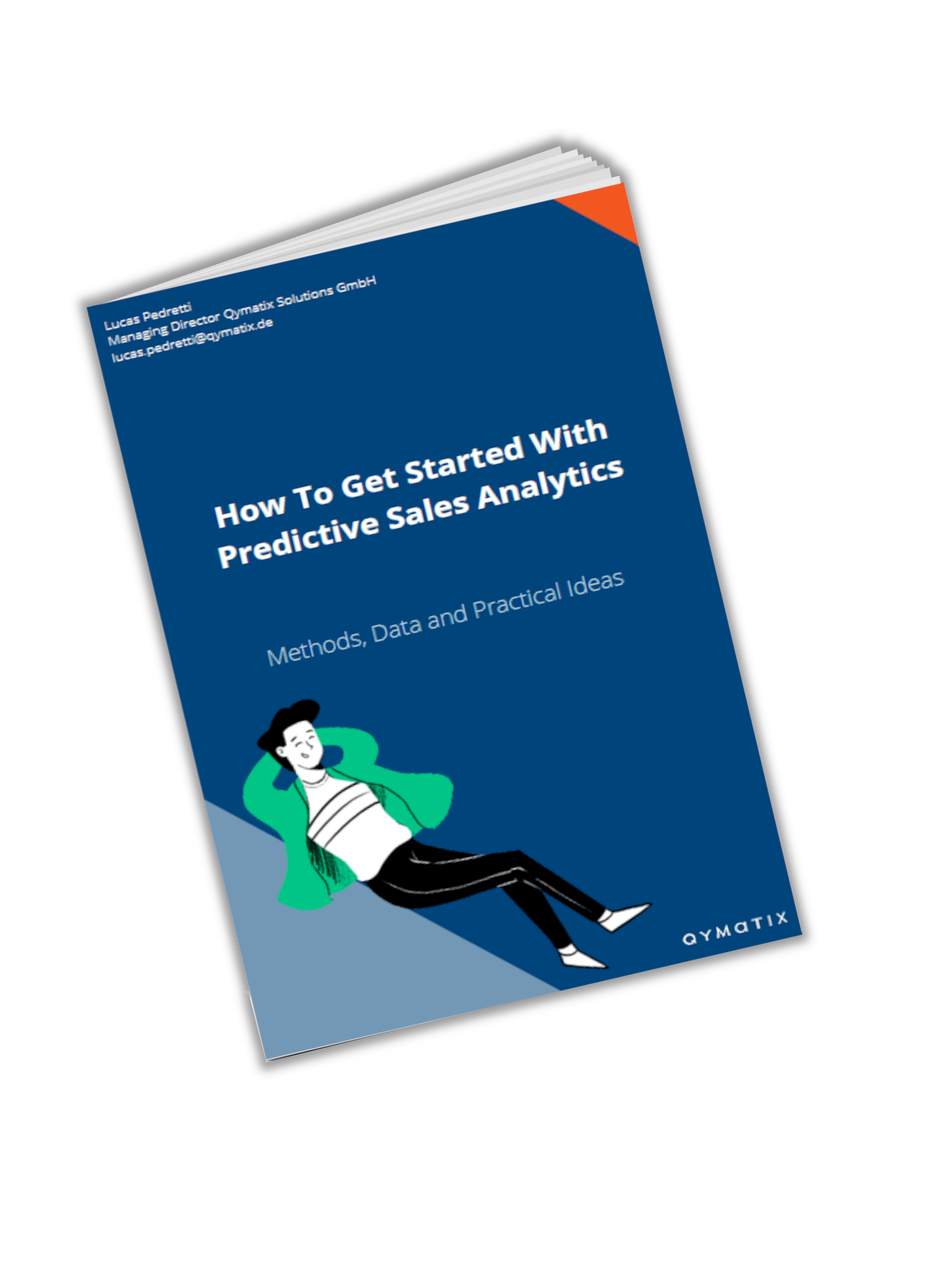The remarkable truth about Predictive Sales Analytics & Controlling

Please enter your Email address
Is predictive sales analytics software the newest secret weapon in B2B?
No organisation will survive the next decade without harvesting the power of predictive sales analytics. However, many sales leaders in Business-to-Business (B2B) still lack the understanding of its benefits or the infrastructure they need.
Some ignore the value of their sales data, languishing unused in their ERP and CRM systems. Furthermore, B2B sales controllers are expected to gather an ever-increasing amount of sales data for their sales leaders to neglect value extraction. Moreover, there is no value in the data if it is not used to improve revenues.
Predictive Sales Analytics offers the key to improved financial results and successful sales controlling. Already a 2013 study by Deloitte, “The Analytics Advantage”, found that 96 % of C-Suite managers believed that analytics – not only in sales – would become more critical in the coming years. The research stated two reasons for this optimistic view. First, a significant amount of data was still not adopted for decision-making. Second, many organisations employed only rudimentary analytical technology.
Extracting value from sales data using predictive sales analytics is a three-step process. First, using the data that organisations are already gathering for decision-making. Wise sales leaders start by asking business questions. Executives can answer these questions with the available ERP and CRM data.
Second, sales controllers can match those business questions with suitable performance indicators. Communication between sales controllers and sales leaders is, of course, vital. Third, accelerating sales processes. Let’s dig into these three steps.
How can Predictive Sales Analytics help a B2B Sales Organization? Fast and Furious.
The days when running a B2B sales organisation had a simple recipe are gone. Nonetheless, some sales leaders seem to follow ancient wisdom. They still believe that sales are just a four-steps dance: hire charismatic Key Account Managers (KAM), train them about company products, point them towards customers, and control them for performance.
Not anymore.
Nowadays, B2B sales world is more complicated. The whole buying experience has changed. Today, buyers are more demanding and better informed, and the competition is fast to obtain any possible advantage.
Direct selling is becoming more expensive. Key Account Managers and Sales Reps are becoming costly consultants. Data is exploiting: ERP & CRM sales data, mobile data, social networks, advanced models and analytical tools. These trends create risks, as well as opportunities.
Company leaders believe that a considerable proportion of their data was still not used for decision-making and that their organisations had limited analytical technology. Experienced sales leaders in B2B know better.
Most, if not all, B2B companies use an Enterprise Resource Planning System (ERP) to run their sales operations. Many also a Customer Relationship Management System (CRM). These two datasets are enough to start harvesting value using predictive sales analytics.
To extract value from ERP and CRM sales data, sales leaders ask first the business questions with a higher impact on revenues. They usually depend on each company, its market challenge, and its sales force. For a complete ROI calculation, managers also consider the cost of answering each question.
Sales leaders in – almost any – B2B business can start inquiring the following:
Which customers have higher upselling or cross-selling sales potential?
Which recurrent buyers are at risk of not buying again?
In which sales plans should we focus because they have better chances of closing?
How should I diagnose how well KAMs are performing?
Sales analytics provides a framework for decision-making based on data, using business questions as a guiding line.
More questions that sales leaders should consider can be found here.
Choosing the Right KPI: predictive sales analytics on the praxis
Once executives have defined the business questions and the sales data, predictive sales analytics depends on deciding what to measure: the key performance indicators (KPI). The business questions determine the KPIs.
There is, again, no simple formula to identify them. Effective sales leaders reflect on the kind of challenge their organisation is facing and the sales data available. This exercise leads to business questions answerable with the ERP and CRM data on hand.
Sales analytics in general (and predictive sales analytics in particular) emphasise the root causes of any business situation. The situation, in turn, influences what performance indicators one should consider. Some examples of possible business questions and their corresponding KPI:
| Performance Question | Predictive KPI |
| Which customers have higher upselling or cross-selling sales potential? | Unfulfilled Potential – Share-of-wallet |
| Which recurrent buyers are at risk of not buying again? | Churn-Risk / Loyalty Ratio |
| How to link activity-based goals with financial results? | Number of orders, transactions, new accounts per KAM. Penetration Ratio across customer base. |
| Which sales plans have better chances of closing? | Average Size Deal, Lifecycle, and other advanced predictive signals |
| How to diagnose how well KAMs are performing? | Ratios: Activities – Sold Per Account vs potential per KAM |
Choosing the right performance indicator is more of a craft than a science. Besides, effective sales leaders concentrate on a reduced set of KPI to avoid the risk of overloading their teams.
Experienced executives are flexible and do not set KPIs in stone. They regularly review their critical sales metrics. Markets can change in one quarter.
Lastly, KPIs are to modify the sales team’s behaviour: which customers, sales plans and sales actions to focus and prioritise. Changing sales team behaviour is a significant challenge that cannot take for long.
Sales controlling with analytics: steer clear and accelerate.
Records are made to be broken. Controlling the sales team and steering it in an encouraging direction will alone not make a significant difference. Speed is of the essence. Sales reps need to move faster than their competitors. B2B organisations aiming to grow revenues employ today artificial intelligence sales analytics software. Constructive coaching is also necessary. Real leaders teach KAM to spend five minutes every day prioritising.
Companies explicitly targeting improvements in sales effectiveness cannot do without sales acceleration. These applications are quickly growing, mainly due to the increased ability to measure its Return on Investment (ROI). A 2014 market study of German B2B sales and marketing executives showed that 30 % of companies had already implemented sales acceleration solutions. This development lags, however, the US, UK, and France.
The financial benefits of a sales acceleration solution and prioritisation using predictive sales analytics are clear to most managers:
Higher Revenues due to increased number of opportunities, win rate and quota attainment
Better demand and sales planning. Reduced sales cycle length.
No need of analytical skills or costly IT projects. Value from ERP and CRM sales data mining.
CALCULATE NOW THE ROI OF QYMATIX PREDICTIVE SALES SOFTWARE
Sales Analytics for Success in Sales Controlling – Conclusion:
The fascinating truth about predictive sales analytics in B2B sales controlling is that although business leaders acknowledge its power, they still haven’t experienced its benefits in full.
These benefits come in three steps. First, using ERP and CRM sales data, sales leaders can ask business questions to add value to their organisations. No two cases are the same. Predictive sales analytics offers a clear pathway, nonetheless to increased revenues and sales efficiency.
Second, sales controllers can match business questions with key performance indicators. There is no one-size-fits-all. Skilled sales leaders evaluate the kind of challenge continuously their organisation is facing, are flexible and act promptly. Communication between management and sales controlling is critical.
Third, accelerate. B2B Sales is always race; competitors and customers do not wait. Once an organisation has defined its business challenge and key performance indicators, swiftly modifying behaviour is critical for success. Predictive sales analytics helps to find cross-selling, up-selling and pricing opportunities faster.
With the help of a predictive sales analytics software, sales leaders can focus on the customers with undiscovered sales potential – before their competitor – while reducing customer churn – before customers stop buying.
Do you have any further questions about Predictive Sales Analytics? We are happy to help!
CONTACT US TODAY FOR YOUR PERSONAL CALL
Free eBook for download: How To Get Started With Predictive Sales Analytics – Methods, data and practical ideas
Predictive analytics is the technology that enables a look into the future. What data do you need? How do you get started with predictive analytics? What methods can you use?
Download the free eBook now.
- We will use this data only to contact you for discussing predictive sales KPIs. You can read here our declaration on data protection.

Further Read:
Link to Huffington Post – The Selling of Sales Acceleration .
Link to Computerwoche – Was ist was bei Predictive Analytics? (in German).
Link to Informationweek – Gartner Magic Quadrant Advanced Analytics: Fast Growth Continues (in German).

